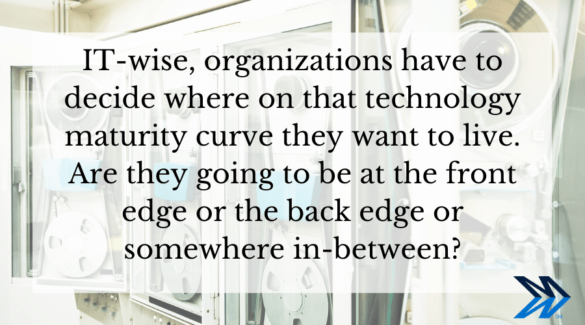April 29, 2021
In the days before almost every business became tech-centric, IT support consisted of on-call computer repair specialists who’d swoop in when Phil in accounting’s desktop crashed, rolling their eyes and sighing while they cleaned up his latest mess. This trope was perhaps personified by Chris O’Dowd in Channel 4’s sitcom “The IT Crowd”. Roy, played by O’Dowd, famously answers the support line “Hello, IT, have you tried turning it off and on again?”.
 Thankfully, that is no longer the case and hasn’t been for years. Users are far more tech-savvy and can often attempt simple troubleshooting actions on their own (ie: turning it off and turning it back on again). Today, things are digital-first. In this age of data security and remote work and cloud everything, IT has become nothing less than indispensable — the spine that keeps an organization upright. Even so, and despite copious evidence, it’s not always treated as such. The result: plenty of IT projects — including well-intended ones — fail to achieve their objectives.
Thankfully, that is no longer the case and hasn’t been for years. Users are far more tech-savvy and can often attempt simple troubleshooting actions on their own (ie: turning it off and turning it back on again). Today, things are digital-first. In this age of data security and remote work and cloud everything, IT has become nothing less than indispensable — the spine that keeps an organization upright. Even so, and despite copious evidence, it’s not always treated as such. The result: plenty of IT projects — including well-intended ones — fail to achieve their objectives.
There are many reasons why failures occur: lack of alignment, no clear definition for success, ignoring the importance of change management, lack of agility, not anticipating risks. For the purposes of this blog, we’ll focus on two that continually come up: Inadequate resourcing and legacy technology. Improvement in both areas is largely dependent on the IT knowledge of those in charge. (Hint: less definitely isn’t more.)
“I’ve seen organizations where senior management views IT as just another cost to bear, so it’s under-resourced and you’re just stuck there,” says Matt Cox, Director of Internal Systems and Security at Mindsight. “But since everybody is increasingly being driven by technology, it seems to me that you need to place more importance on it. And not just to keep up with your peers or so you can brag about your new whiz-bang-blinky-box on the golf course. IT investment has to be strategic so it delivers value to the business.”
And it always starts at the top. Business leaders who know little about IT must surround themselves with expert internal or external advisors, Cox says. Better yet, more leaders should be IT experts with business training.
Inadequate Resources
“Most of the time, CEOs have backgrounds in business or sales and marketing or engineering. They have to hire skilled IT people — whether outside consultants or in-house specialists — they trust and can communicate well with. Your failures are usually going to be around communication and whether project leaders have identified and sufficiently detailed business goals so solutions meet those requirements. It all comes down to whether or not there’s actually a need.” With the right people in place, Cox explains, companies are in a far better position to determine what they need and don’t need from an IT perspective.
But getting the resources, whether talent or funding, to successfully implement a project can often be a challenge. Cox says many smaller organizations lack the in-house skill sets needed to achieve every IT goal. Security experts for instance don’t come cheaply. A full-time employee with benefits can range anywhere from $250,000 – $350,000. Oftentimes, the larger the organization, the greater the expense for talent. Additionally, project costs are often underestimated making it difficult to bring an initiative to a successful outcome. A recent CIO.com survey on the State of the CIO notes that only 49% of IT leaders expected their budgets to increase in 2021, while 39% saw them staying flat and12% were planning for a decrease. Without proper project financial management and the right skill sets, it’s no surprise IT projects continue to fail. That’s why organizations often look to outside consultants like Mindsight who provide not only the broad IT expertise, but the financial acumen and requirements to help ensure projects are successfully executed.
Legacy infrastructure
There’s a lot of it sitting in data centers and computer rooms. Most every company has hardware that is aging or well past its time that poses risk to the organization, is often incompatible with newer technology and is expensive to maintain. And it can wreak havoc on the best positioned IT projects. Either IT ignores the legacy infrastructure, assumes it will support a business-critical application for instance, or recognizes a potential problem and chooses to forge ahead anyway with the project until a problem occurs and everything comes to a stop. This is like building a house on a weak foundation. It’s another reason why organizations partner with managed services providers so infrastructure is continually upgraded and secure.

“The IT market is constantly moving,” Cox says, “and a lot of vendors are building obsolescence into their product lines because they can’t support those lines indefinitely. Customers also want the fastest, newest stuff, so vendors have to limit what they’ll continue to support or it becomes cost-prohibitive. IT-wise, organizations have to decide where on that technology maturity curve they want to live. Are they going to be at the front edge or the back edge or somewhere in-between?”
Ultimately, Cox says, avoiding IT failures comes down to clear and consistent communication. And that requires the right people in the right roles with the right investment making and sharing informed decisions that will move an organization forward. Might that process involve a bit of eye rolling and/or sighing? Sure. IT has come a long way, but some things never change.
About Mindsight
Mindsight, a Chicago IT services provider, is an extension of your team. Our culture is built on transparency and trust, and our team is made up of extraordinary people – the kinds of people you would hire. We have one of the largest expert-level engineering teams delivering the full spectrum of IT services and solutions, from cloud to infrastructure, collaboration to contact center. Our highly-certified engineers and process-oriented excellence have certainly been key to our success. But what really sets us apart is our straightforward and honest approach to every conversation, whether it is for an emerging business or global enterprise. Our customers rely on our thought leadership, responsiveness, and dedication to solving their toughest technology challenges.
About The Expert
Matt Cox is the Director of Internal Systems and Security at Mindsight, and has over 20 years of experience in Telecommunications, Information Technology and Network Management. In his role at Mindsight, Matt has the uncanny ability to communicate complex technical ideas to a broad audience. He is passionate about information security and using technology to improve business outcomes and is currently pursuing CISSP certification. When he’s not focused on the hyper-technical, Matt enjoys boating, fishing, and lock picking.
